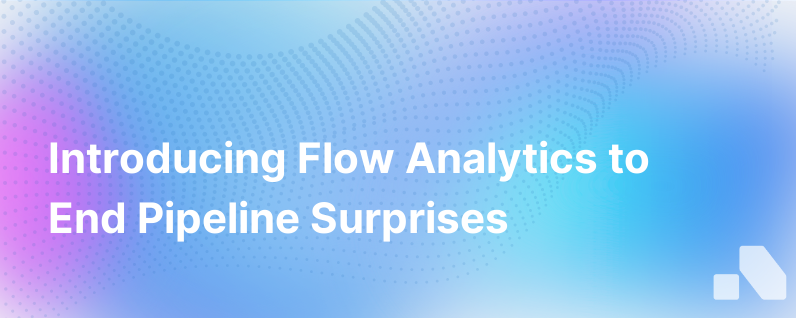
In the evolving landscape of B2B sales, one thing remains constant – the necessity of an accurate, predictable sales pipeline. The old adage of "what gets measured gets managed" holds particularly true in a domain where foresight equals revenue. Yet, time and again, many sales teams find themselves blindsided by unexpected pipeline fluctuations, which can significantly impact the health and success of a business. This is where the new paradigm of 'Flow Analytics' shines, ensuring that sales pipelines aren't just monitored, but also intelligently analyzed to forecast changes before they turn into surprises.
Garnering Insights with Flow Analytics
Flow Analytics is a cutting-edge approach to sales pipeline management, leveraging advanced data analysis to track and predict the flow of deals through the pipeline. It allows sales leaders to discern patterns, identify bottlenecks, and anticipate the unexpected, thereby enabling timely strategizing and interventions when needed. This method of analytics considers various dynamics factors, such as deal velocity, deal size changes, and stage-to-stage conversion rates.
Dissecting Pipeline Flow
Analyzing the sales pipeline with Flow Analytics entails a deep dive into numerous components that inform on the health and progress of sales opportunities. Here's a breakdown of this approach:
Pipeline Inflow and Outflow
Firstly, we assess the volume of opportunities entering and leaving the pipeline within a specific timeframe. This inflow/outflow analysis doesn't just count the number of deals; it evaluates the potential revenue each opportunity represents.
Conversion Rates and Velocity
Even the most promising pipeline can falter without understanding how deals move through it. Conversion rates provide insight into the effectiveness of sales tactics at each stage, while velocity sheds light on the speed with which deals transition from one phase to the next.
Average Deal Size and Value Trends
A critical metric that often goes overlooked is the average size of the deals in the pipeline. Analyzing trends over time can reveal whether the team is succeeding in upselling or if deal values are gradually declining.
Historical Patterns and Seasonality
Sales don't happen in a vacuum; they're often influenced by market trends and seasonal factors. Historical data can highlight recurring patterns, allowing sales teams to pivot their strategies accordingly.
Leading Indicators and Predictive Analytics
Beyond looking at what has happened, Flow Analytics employs predictive modeling to anticipate future pipeline behavior. By analyzing leading indicators, sales leaders can forecast potential shortfalls or surges in the pipeline, staying proactive rather than reactive.
The Role of AI and Machine Learning
Flow Analytics doesn't just rely on static, historic data. Artificial Intelligence (AI) and machine learning algorithms play a crucial role in deciphering complex data patterns, processing vast amounts of information, and generating predictions with a level of accuracy impossible to achieve manually.
When AI and machine learning join forces with Flow Analytics, the system can:
- Identify nuanced correlations that humans might miss.
- Learn continuously from data inputs, improving predictive accuracy over time.
- Provide actionable insights that can be deployed almost instantaneously.
The Value Flow Analytics Brings to Your Sales Team
Embracing Flow Analytics offers tangible benefits to sales organizations of all sizes:
Enhanced Forecast Accuracy
Sales leaders are constantly under pressure to provide accurate forecasts. With Flow Analytics, forecasts are based on comprehensive data analyses rather than gut feeling or overly optimistic assumptions, mitigating the risk of unexpected downturns.
Proactive Sales Management
Armed with predictive insights, sales managers can address issues before they become problematic. Whether it's coaching a rep with a slowing deal velocity or adjusting strategies to cope with market shifts, being proactive keeps the pipeline robust.
Streamlined Sales Processes
Flow Analytics often highlights inefficiencies within the sales process. This insight is invaluable for streamlining operations, aligning sales efforts with buyer behavior, and ultimately reducing the length of the sales cycle.
Better Resource Allocation
Understanding the ebb and flow of the sales pipeline helps in optimal resource allocation. Whether it's doubling down on high-value proposals or providing more support to complex negotiations, resources can be intelligently directed where they're most needed.
Confidence in Decision Making
When sales decisions are backed by solid data, confidence in those decisions increases. This confidence permeates the team and can elevate the overall performance of the sales organization.
Integrating Flow Analytics with Aomni
Aomni, an AI platform for B2B sales, perfects the art of Flow Analytics by consolidating all dimensions of pipeline analysis into a user-friendly interface. This powerful tool synthesizes real-time data, leveraging AI to predict and guide sales team actions towards strategic selling and away from blindsiding turns in the pipeline.
Closing Thoughts
In conclusion, Flow Analytics promises to be a transformative force in strategic sales management. It empowers sales teams with foresight, equipping them with the knowledge and capabilities needed to navigate ever-changing market conditions with precision and assertiveness.
As the technology matures and becomes more integrated into everyday sales operations, we can expect its predictive capabilities to only get sharper, ultimately eliminating those all too familiar pipeline surprises that can derail a business's momentum. With Flow Analytics, and platforms like Aomni enhancing its application, the future of sales pipeline management is not only clear but also incredibly bright.